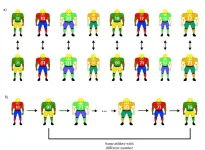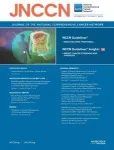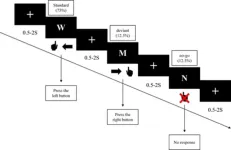(Press-News.org) In 2019, an ESPN report explored the reasons so many football wide receivers prefer to wear jersey numbers between 10 and 19. The story found that many of the athletes simply believed the lower numbers made them look faster and slimmer than the higher numbers traditionally assigned to their position.
Ladan Shams, a UCLA professor of psychology and neuroscience, was quoted in the story and offered a psychological explanation for the phenomenon. But she emphasized that there was no scientific research on the topic.
Now there is.
A new UCLA study published in the journal PLOS ONE reveals that those wide receivers were onto something.
In two experiments, subjects consistently said that images of players in jerseys numbered from 10 to 19 looked thinner than those in jerseys numbered from 80 to 89, even when the body sizes were the same. The finding suggests that previously learned statistical associations between numbers and sizes influence the perception of body size.
“How we perceive the world is highly influenced by our prior knowledge,” said Shams, the paper’s senior author. “In our daily lives, numbers written on objects — on a bag of sugar in the supermarket or weights in the gym — usually represent the magnitude of the objects. The higher the number, the bigger or more massive the object generally is.
“Previous research has established that our brains are very good at detecting and storing statistical associations and regularities, unbeknownst to us, and those associations can shape future perception.”
A longtime NFL rule required wide receivers to wear uniform numbers between 80 and 89, but the league changed the restriction in 2004, opening the door for pass-catchers who preferred lower numbers on their uniforms. By 2019, when ESPN published its story, nearly 80% of wide receivers wore a jersey number between 10 and 19.
Shams is a specialist in the science of perception, and when her other work ground to a halt during the COVID-19 pandemic, she returned to the question about jersey numbers. With her research group, she devised an online study to test her suppositions about the popularity of lower numbers.
Respondents were shown computer-generated images of players in identical poses — but with different body sizes and skin and jersey colors — and were asked to judge their slenderness. Subjects saw each player twice — once each in jerseys with high and low numbers. In general, the players in jerseys numbered from 10 to 19 were perceived as thinner than players in jerseys numbered 80 to 89, regardless of their body size and their skin or jersey colors.
After pandemic restrictions eased, the researchers repeated the experiment in person.
This time, they addressed concerns that because the numeral 8 is wider than 1, simply the amount of jersey space occupied by numbers from 80 to 89 could make players look larger. So they chose number combinations that used the same numerals but varied only in which digit came first: 17 and 71, 18 and 81, 19 and 91.
In this second experiment, subjects still perceived the players with higher numbers to be huskier than players with lower numbers, although the effect was somewhat smaller than in the first iteration.
Shams said the results strongly support the hypothesis that when processing perception of body size, the brain leans on learned associations between numbers and objects’ size attributes. That finding is consistent with previous research showing that statistical learning is a fundamental and universal learning mechanism.
Those learned associations, Shams said, generally help the brain interpret sensory input — the pattern of light receptor responses in the eye, for example — because sensory input can be noisy, unreliable and ambiguous. The ability to perceive the world faster and more correctly is critical for survival, she said.
How viewers perceive football players’ body size likely has little effect on the athletes’ performance. But in other areas of life, such perceptual and cognitive biases can be more harmful — for example, when they influence judgment, decisions and behavior toward people or social groups, a phenomenon often referred to as implicit bias. If a group is frequently associated with negative qualities, others are much more likely to treat people in that group accordingly, whether they realize it or not.
“Our work highlights the importance of representation,” Shams said. “We need to see all kinds of people doing the full diversity of things people can do. We can use the statistical learning power of our brains to reduce implicit bias.”
END
Does this number make me look fat?
UCLA psychologists confirm that lower jersey numbers make football players look thinner
2023-09-06
ELSE PRESS RELEASES FROM THIS DATE:
Clues from patients with rheumatic diseases point to a potential driver of long COVID
2023-09-06
In an analysis of samples from patients with rheumatic diseases, researchers from across Mass General Brigham found evidence that prior infection with a pre-pandemic coronavirus that causes the common cold may help set the stage for the development of long COVID
The study points to a potential marker of long COVID, which could inform clinical trials and may help explain why some patients develop long COVID
A patient population at increased risk for severe COVID-19 may help researchers understand why some people develop long-term, persistent symptoms (long COVID) while others do not. Rheumatologists from Brigham and ...
Microdevices implanted into tumors offer new way to treat brain cancer
2023-09-06
The shape and size of a grain of rice, the new device can conduct dozens of experiments at once to study the effects of new treatments on some of the hardest-to-treat brain cancers.
Researchers from Brigham and Women’s Hospital, a founding member of the Mass General Brigham healthcare system, have designed a device that can help test treatments in patients with gliomas, a type of tumor that originates in the brain or spinal cord. The device, which is designed to be used during standard of care surgery, provides unprecedented insight into the effects of drugs on glioma ...
Ag tech can cut billions of tons of greenhouse gas emissions
2023-09-06
ITHACA, N.Y. - As the Earth’s human population grows, greenhouse gas emissions from the world’s food system are on track to expand. A new study demonstrates that state-of-the-art agricultural technology and management can not only reduce that growth, but eliminate it altogether by generating net negative emissions – reducing more greenhouse gas than food systems add.
In fact, employing additional agricultural technology could result in more than 13 billion tons of net negative greenhouse gas emissions each year, as the world seeks to avoid dangerous climate extremes, according to research published Sept. 6 in PLOS Climate.
The work was led by Benjamin ...
The sense of order distinguishes humans from other animals
2023-09-06
Remembering the order of information is central for a person when participating in conversations, planning everyday life, or undergoing an education. A new study, published in the scientific journal PLoS One, shows that this ability is probably human unique. Even the closest relatives of humans, such as bonobos, do not learn order in the same way.
“The study contributes another piece of the puzzle to the question of how the mental abilities of humans and other animals differ, and why only humans speak languages, plan space travel, and have learned to exploit the earth so efficiently that we now pose a serious ...
Footballers wearing jerseys featuring small numbers are rated as more slender than those wearing big numbers, in experiments indicating how visual perception may be influenced by cognition
2023-09-06
Footballers wearing jerseys featuring small numbers are rated as more slender than those wearing big numbers, in experiments indicating how visual perception may be influenced by cognition
###
Article URL: https://journals.plos.org/plosone/article?id=10.1371/journal.pone.0287474
Article Title: Big number, big body: Jersey numbers alter body size perception
Author Countries: USA
Funding: The authors received no specific funding for this work. END ...
New battery holds promise for green energy
2023-09-06
Jimmy Jiang envisions a future where every house is powered by renewable energy stored in batteries.
In his chemistry lab, Jiang and his students at the University of Cincinnati have created a new battery that could have profound implications for the large-scale energy storage needed by wind and solar farms.
Innovations such as UC’s will have profound effects on green energy, Jiang said. Batteries store renewable energy for when it’s needed, not just when it’s produced. This is crucial for getting the most out of wind and solar power, he said.
“Energy ...
Amish found to be under-vaccinated for COVID-19 but not unvaccinated
2023-09-06
UNIVERSITY PARK, Pa. — This summer, viral misinformation claimed that the Amish did not vaccinate against COVID-19 and, as a result, had a death rate 90 times lower than the rest of the United States. Now, a Penn State study is the first to provide geographically broad and population-wide evidence that while the Amish-populated counties across the nation tend to have lower vaccination rates than other populations, they are not entirely unvaccinated.
The research was published recently in the journal Population Research and Policy Review.
The Amish are a distinctive Christian subculture that traces its roots to the 16th century Protestant ...
Groundbreaking study reveals new insights into behavioral inhibitory control through functional neuroimaging
2023-09-06
A recent article published in Volume 3 of the journal Psychoradiology, researchers from Sichuan Normal University introduced an innovative Three-Choice BIC paradigm that merges the GNG and two-choice oddball (TCO) tasks. This study engaged 48 college students who responded to varied stimuli using designated keys and restrained responses to no-go stimuli. Employing functional neuroimaging coupled with conjunction and ROI analyses, the researchers sought to unveil unique neural pathways linked to BIC ...
Stress test abnormalities reveal more than just cardiovascular risks, Mayo Clinic study finds
2023-09-06
ROCHESTER, Minn. — The treadmill exercise test with electrocardiogram (ECG), also known as an exercise stress test, is one of the most familiar tests in medicine. While exercise testing typically is focused on diagnosing coronary artery disease, a recent study from Mayo Clinic finds that exercise test abnormalities, such as low functional aerobic capacity, predicted non-cardiovascular causes of death such as cancer in addition to cardiovascular-related deaths. These new findings are published in Mayo Clinic Proceedings.
The exercise stress test is noninvasive, easily available and provides important diagnostic information. In addition to the ECG itself, ...
Canine health data to guide new cancer study
2023-09-06
DENVER/Sept. 6, 2023 — A newly funded study will evaluate both the frequency and major risk factors for cancer in golden retrievers, a breed commonly affected by the disease.
The study will use data from Morris Animal Foundation’s Golden Retriever Lifetime Study, which is one of the largest and most comprehensive canine health studies in the world. The study will also incorporate data from Veterinary Companion Animal Surveillance System (VetCompass), a not-for-profit research project based at the Royal Veterinary College ...
LAST 30 PRESS RELEASES:
Ticking time bomb: Some farmers report as many as 70 tick encounters over a 6-month period
Turning garden and crop waste into plastics
Scientists discover ‘platypus galaxies’ in the early universe
Seeing thyroid cancer in a new light: when AI meets label-free imaging in the operating room
Neutrophil-to-lymphocyte ratio may aid risk stratification in depressive disorder
2026 Seismological Society of America Annual Meeting
AI-powered ECG analysis offers promising path for early detection of chronic obstructive pulmonary disease, says Mount Sinai researchers
GIMM uncovers flaws in lab-grown heart cells and paves the way for improved treatments
Cracking the evolutionary code of sleep
Medications could help the aging brain cope with surgery, memory impairment
Back pain linked to worse sleep years later in men over 65, according to study
CDC urges ‘shared decision-making’ on some childhood vaccines; many unclear about what that means
New research finds that an ‘equal treatment’ approach to economic opportunity advertising can backfire
Researchers create shape-shifting, self-navigating microparticles
Science army mobilizes to map US soil microbiome
Researchers develop new tools to turn grain crops into biosensors
Do supervised consumption sites bring increased crime? Study suggests that’s a myth
New mass spec innovation could transform research
Maternal nativity, race, and ethnicity and infant mortality in the US
Migration-related trauma among asylum seekers exposed to the migrant protection protocols
Jupiter’s moon Europa has a seafloor that may be quiet and lifeless
SwRI upgrades nuclear magnetic resonance laboratory for pharmaceutical R&D
House sparrows in northern Norway can help us save other endangered animals
Crohn's & Colitis Foundation survey reveals more than 1/3 of young adults with IBD face step therapy insurance barriers
Tethered UAV autonomous knotting on environmental structures for transport
Decentralized social media platforms unlock authentic consumer feedback
American Pediatric Society announces Vanderbilt University School of Medicine as host institution for APS Howland Visiting Professor Program
Scientists discover first method to safely back up quantum information
A role for orange pigments in birds and human redheads
Pathways to net-zero greenhouse gas emissions for Southeast Asia
[Press-News.org] Does this number make me look fat?UCLA psychologists confirm that lower jersey numbers make football players look thinner





